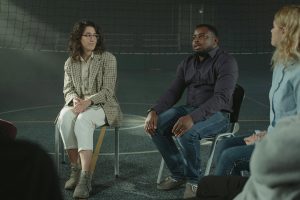On June 8, 2020, I had a dissociative episode that nearly resulted in suicide. When I say ‘nearly,’ I mean that had I not called a therapist that night, I wouldn’t have been there by the next week. This probably comes as a surprise to many who know me. I’m happy and bubbly and cheerful, and I love life. But that’s the me I wanted to be, the me I love being, and the truest version of myself. Unfortunately, that’s not the me I’ve always been able to be.
When I was 19, I was diagnosed with Complex Post Traumatic Stress Disorder (CPTSD). Unknowingly, I suffered with it my entire life. I thought everybody had uncontrollable anger in them. I thought everybody had an anxiety attack when somebody put a coffee cup down too loud. I thought everybody couldn’t breathe when a person in an authority position told them that they needed to talk. I thought everybody had a list.
I want to touch on the list. Because it ran my life for 26 years. From the earliest time I can remember, I’ve always had the list. A constant presence ran through my mind reminding me of every bad thing that had ever happened to me, every bad thing I was forced to do, everything wrong about myself, every failure, potential failure, and moment I stepped out of line. The list was everything I had to do in a day, a week, a month, a year. It was a constant reminder that I was not good enough. It reminded me that I was a monster. That if anybody found out what was on the inside of me, they would know I’d tricked them into loving me. They would know I was a terrible person, and they would hate me for it. The list stole my breath and my potential. It took my brain away from me. It told me I should die. Every day. Every time I drove past a semi-truck, the list spoke up. Every time I drove across a bridge, the list spoke up. Every time I failed, the list spoke up. Every time I succeeded, the list spoke up.
I did three years of cognitive-behavioral therapy in college. It helped me to cope with my symptoms, but it didn’t fix anything. It didn’t make the list go away. I only learned how to have a panic attack and then just go to work afterward. I learned how to think about suicide while I sat in class instead of skipping class to think about it. I learned how to dissociate wherever I went instead of doing it at home. And, boy, was I dissociating! After the assessment in June, I learned I was dissociating around 80% of the time I was awake. If you’ve ever talked to me, there’s a chance that half my brain wasn’t there with you.
I started eye movement desensitization and reprocessing therapy (EMDR) the day after my breakdown. I tried not to go, but my husband told me it was either therapy or the psych ward because he couldn’t lose me. Without EMDR, he would have. He put me in the car, and he drove me to therapy twice the first week and then once a week for the next two weeks until I adjusted and could drive myself. Typically, a person who begins EMDR does talk therapy for a while to adjust and to get ready for the next stages. However, I scored so high on the dissociative areas of my mental health assessment that the therapist was afraid I wouldn’t make it more than a month without an intervention. I was ready for EMDR.
After my third reprocessing session, I was able to listen to music while driving – something I hadn’t done in three years. It became too dangerous for me to drive alone while simultaneously listening to music. I switched to podcasts because they forced me to pay attention instead of going somewhere else in my head. Also, after my 3rd session, the list in my brain got quieter. By the beginning of July, it was gone. Now, I can’t bring it back, and I don’t want to!
I am able to read a book without needing the TV on in the background. I can turn on movies now and actually watch. If you call me on the phone, I’m not scrolling through Facebook while I talk to you. I haven’t set “forgotten food” kitchen fires in the past month. I haven’t forgotten a knife in the dishwater and sliced my fingers open. I’m more patient, empathetic, understanding, and kind. I’m more focused and engaged. I’m excited instead of excited and anxious. And most of all, I no longer have CPTSD.
After twelve sessions, I retook my assessment this week. My scores no longer fall into the range for CPTSD. At nineteen, I was told I’d have it for the rest of my life and that I needed to learn how to cope with it. I thought my brain would be broken forever – because that’s how I saw my trauma. Just yesterday, I found out that my brain has healed so much in such a short time that I no longer have the boogeyman living in it. EMDR literally saved me. My brain works beautifully and better than it has my entire life. The relief I feel is better than anything I’ve ever experienced.
If you have read this and can identify with parts of it, EMDR may be for you – or it might not be. It doesn’t work for my husband because he can’t visualize (a disorder called aphantasia). Although it’s worth giving it a chance, I won’t tell you it is going to be easy, because it isn’t. It is the hardest thing I’ve ever done. It is very real work, and you will feel exhausted after every session, but it is worth it. I’m not sharing this story because I want your sympathy, or because you need to apologize to me. In fact, I want the opposite. Celebrate with me. Cheer with me. Heal with me. Nobody deserves to have a boogeyman living in their brain, and everybody deserves to feel the way I feel today.
Online Resources to Learn More
- https://www.emdr.com/what-is-emdr/
- https://www.emdria.org/about-emdr-therapy/
- https://www.healthline.com/health/emdr-therapy#bottom-line
- https://www.youtube.com/watch?v=lOkSm90f2Do
- https://www.youtube.com/watch?v=1IPsBPH2M1U
- https://www.youtube.com/watch?v=mxcs20e-fuU
- https://www.youtube.com/watch?v=GXSlAfoJiAg
- https://www.ptsd.va.gov/understand_tx/emdr.asp
- https://www.apa.org/ptsd-guideline/treatments/eye-movement-reprocessing
If you or someone you know experiences mental health issues, it is important to seek help from a qualified professional. Our Resource Specialist can help you find expert mental health resources to recover in your community. Contact us now for more information on this free service to our users.
About the Author: Destiney Amiott is a Kentucky educator and an advocate for equitable access to mental healthcare. Diagnosed with CPTSD from childhood trauma, Destiney used EMDR to heal towards her healthy self and hopes to encourage others to find mental healthcare that fits their needs.
The opinions and views expressed in any guest blog post do not necessarily reflect those of www.rtor.org or its sponsor, Laurel House, Inc. The author and www.rtor.org have no affiliations with any products or services mentioned in the article or linked to therein. Guest Authors may have affiliations to products mentioned or linked to in their author bios only.
Recommended for You
- The Truth about Relapse in Addiction Recovery - April 14, 2025
- The Power of Peer Support in Mental Health Recovery - April 10, 2025
- Artificial Intelligence in Anxiety Management: How AI Helps Users Cope with Anxiety Symptoms - April 3, 2025





